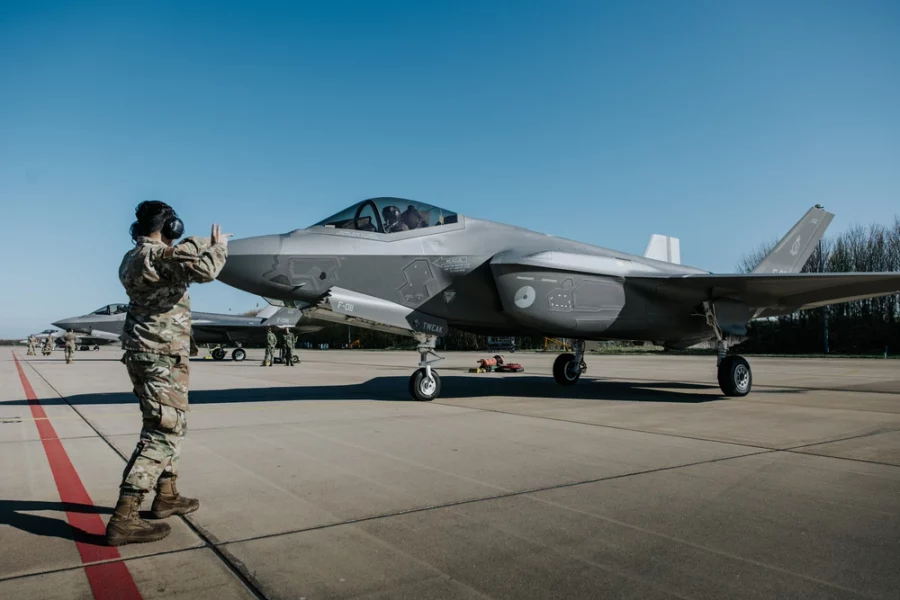Dutch F-35s, using a Lockheed Martin-developed communications gateway, shared classified data with a Dutch command-and-control system to achieve a kill on a ground target during the NATO exercise Ramstein Flag earlier this month, the company announced this week. It was the first time the system was operated outside the U.S.
Ramstein Flag, now in its second year, has quickly become one of NATO’s biggest air exercises. This edition featured 90 aircraft from 15 countries operating from 12 allied air bases, coordinated from The Netherlands’ Leeuwarden Air Base. Officials said they focused on counter-anti access/area denial missions, integrated air and missile defense, and Agile Combat Employment.
For the real-time, live-fly communications gateway demonstration, Royal Netherlands Air Force F-35s flew in an Anti-Access Area Denial environment and detected, identified, and passed targeting data on “multiple simulated ground effectors via Multifunction Advanced Datalink through a Skunk Works’ Open Systems Gateway (OSG) into Keystone,” a Dutch command and control system.
Skunk Works is Lockheed’s advanced development unit, based in Palmdale, Calif. The MADL is the secure datalink system that allows F-35s to communicate with each other while preserving their stealth.
Keystone fed the data to a ground-based rocket artillery platform, “which engaged a ground target and confirmed successful takedown, effectively closing the loop. This entire process was executed from start to finish in a matter of minutes,” the company said in a press release. The ground target was a grouping of Surface-to-Air Missile systems.
“This is a first, and a significant step forward in multi-domain integration, proving F-35 interoperability between several allied nations in real-time,” Lockheed said.
Through a spokesperson, the company said the gateway was “an evolution from Project Missouri,” a gateway experiment dating back to 2013 meant to connect the F-35 and F-22.
“We have continued to refine and build upon our experimentation over the last 12 years, and with the support of the Missile Defense Agency, were able to prove this capability alongside our F-35 partners last week,” the spokesperson said. “This is the same architecture and technology that was used by Lockheed Martin to integrate F-35 and F-22 in the past.”
The company further said that the gateway “can be leveraged with any platform/sensor/shooter” and is “aircraft agnostic, but we’re currently [focused on] the F-35.” It can also be leveraged with other countries’ C2 systems.
This latest demonstration also builds on work done by the U.S. and United Kingdom for Project Deimos this past December, when an F-35 flying from Lockheed’s facility in Fort Worth, Texas, shared live classified data through the gateway with a British command-and-control system—the first time an F-35 had shared such data with a non-American C2 system.
Ramstein Flag, which Lockheed described as a “collaboration” between U.S. Air Forces in Europe and Skunk Works, went a step further by operating the gateway in Europe for the first time. “We leveraged the USAFE-owned Deployable All-Domain Ground Gateway Rig which contains the gateway within the system,” the company said.
Use of the gateway helps F-35 users with “unlocking the vast amount of data” collected by an F-35, the company said, enabling allied air and missile defense systems to receive precise targeting information that then allowed them to “detect, track and defeat threats more effectively.”
The system helps strengthen collective defense by enhancing the situational awareness of joint forces, allowing them to “respond more quickly and decisively” to threats, Lockheed said.
“Our goal is to make interoperability a reality for our allied partners by maximizing the information available on the F-35,” the company said.
Ramstein Flag, which concluded April 11, is modeled after the U.S. Air Force’s Red Flag exercises that test Airmen to “train like they fight” in realistic combat scenarios. The NATO exercise also has a heavy emphasis on information sharing, interoperability, and support of special forces and naval units.
The exercise also bolstered F-35 interoperability through cross-servicing: having maintainers from different countries work on each others’ jets. Crew chiefs from the U.S. and the Netherlands launched two F-35s each from the others’ country.
